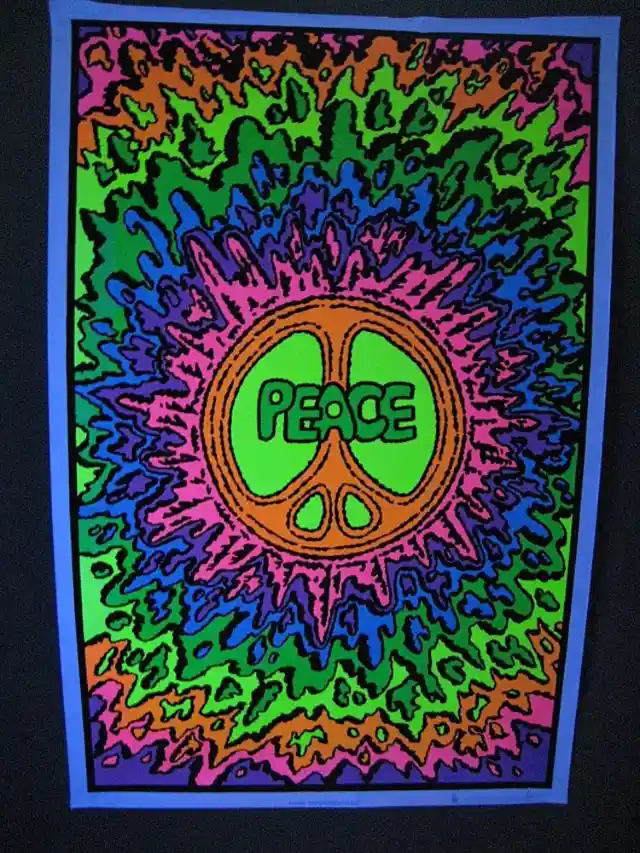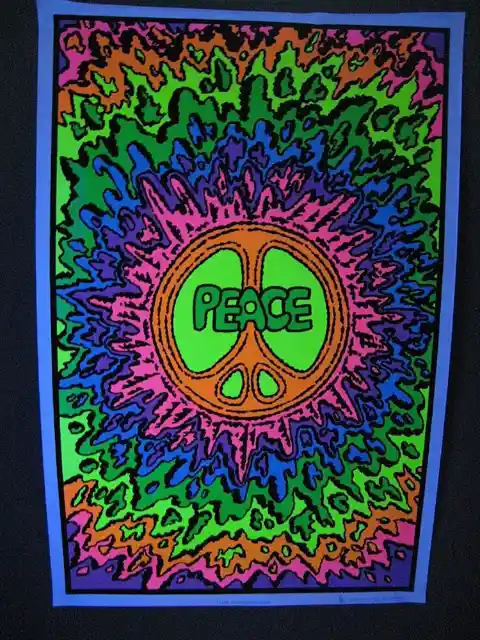From pastel suits to vivid geometric patterns, the 1970s were a colorful decade, and blacklight posters were no exception. These wall adornments were a major statement of 70s expression, depicting R.Crumb cartoons, virtuous warriors, and Marvel superheroes (long before The Avengers dominated the box office).
Blacklight posters appealed to all types of people, who would take in the stunning visuals and fluorescent glow while listening to the psychedelic tunes of the era. So, how exactly did blacklight posters become a thing, and why were they present in every 70s kid’s bedroom?


Day-Glo Paint Was a New Phenomenon
Day-Glo and glow-in-the-dark paint were just beginning to go mainstream when manufacturers of blacklight posters noticed it. Created by the Switzer brothers in the 1930s, fluorescent paint had been previously used by the military to paint aircraft and supply fabrics. However, the Day-Glo Color Corp didn’t bring the ink to the mass market until the 1950s.
There’s a reason the term “new toy” exists. People became fascinated by the relatively new product, experimenting with glow-in-the-dark paint as a means of artistic expression. While creatives loved to play with it, the product didn’t start to become widely accepted by mainstream society until the 1960s.
Science Makes Blacklight Posters Magical
What makes blacklight posters so awesome to look at? Like with many awesome things, it comes down to science.
“Fluorescence works through electron displacement—all fluorescence, from synthetic blacklight posters to natural fluorescent minerals around the world,” says Nick Padalino, owner of Electric Ladyland Museum in Amsterdam.
Blacklight posters are essentially one big optical illusion, as they trick the eye into seeing ultra-bright colors when hit by a black light. Once a poster is hit with ultraviolet energy (the kind that the naked eye isn’t used to), they appear to be actually putting off the light and bringing the viewer into a trance.
They Transport You to Another World
Have you ever rubbed your eyes for too long and begun to see a psychedelic vision of shapes and colors? Blacklight posters were a bit like that, but way cooler. Before there were iPhones and social media, the kids of the 70s would frequently throw on a classic rock album and gaze deeply into their blacklight poster, getting lost in the range of colors and shapes.
When your parents tell you that this is “what they did for fun” back in the day, they weren’t kidding. The intricate designs and details in a blacklight poster could keep you entertained for hours on end.
Glow in the Dark Paint was an Advertising Tool
It’s no surprise that this eye-catching product was used by advertisers and promoters before entering the mass market with blacklight posters. Glow in the Dark paint was fun, catchy, and had the edge that San Francisco-based promoters were looking for – creating a “trippy” vibe that attracted the right crowd.
As creatives previously used the product to change up their work, glow-in-the-dark paint was frequently used in publications like the San Francisco Oracle, as well as by underground comic book artists. As fans began seeing this new art on promotional materials, glow-in-the-dark paint began to truly take off.
The Rise and Fall of Blacklight Posters
For a good while, the blacklight poster was literally the light of every 70s kid’s life. Even if they weren’t into psychedelics, it was an item everyone had in their home, from the big cities to the suburbs.
Of course, it was at the height of its popularity that the blacklight poster started to decline. It’s not cool anymore when your younger sister has one, right? Blacklight posters faded into relative obscurity during the 80s’, but could still be spotted here and there. Even today, they can still be quite fun to look at!